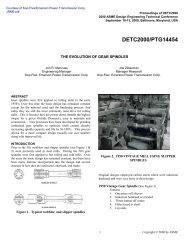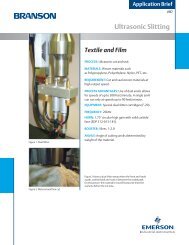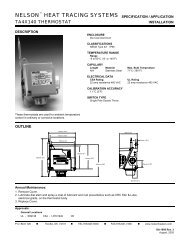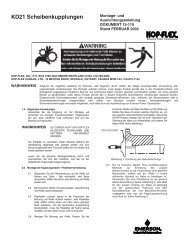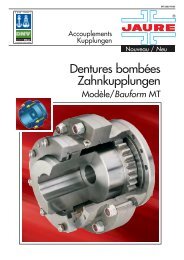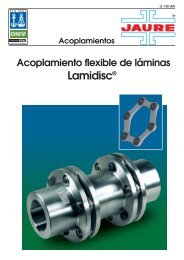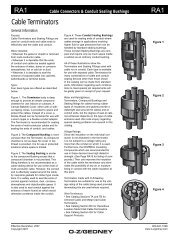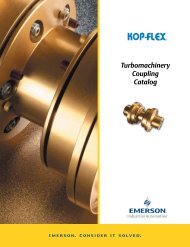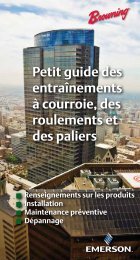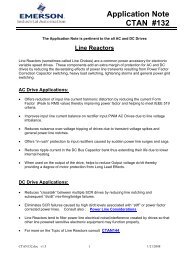Kop-Flex Industrial Coupling Product Catalog - Form 8887E
Kop-Flex Industrial Coupling Product Catalog - Form 8887E
Kop-Flex Industrial Coupling Product Catalog - Form 8887E
You also want an ePaper? Increase the reach of your titles
YUMPU automatically turns print PDFs into web optimized ePapers that Google loves.
Gear Spindles<br />
Troubleshooting and Reverse Engineering<br />
Sub-surface failure (pitting and spalling): Since spindle gear teeth see high repetitive loads, pitting and<br />
spalling is common, particularly at high angles or in spindles with poor tooth contact. Repeated cycles cause more<br />
pitting and further erosion of the surface (spalling). Large spalls sometimes look like “worm tracks.” If the case is not<br />
deep enough to support the high repetitive loads, the case sometimes cracks (crushes like asphalt). This eventually<br />
causes pieces of the surface to break away, leaving voids, which can also look like “worm tracks.”<br />
CAUSE<br />
(1) Poor tooth contact. When few teeth are in<br />
spindle’s contact, these teeth carry a disproportionate<br />
load. This then causes sub-surface cracking, which can<br />
produce pits and eventually spalls that cause tooth in distress.<br />
Poor tooth contact is due to either high operating<br />
misalignment or improper tooth shape (usually caused<br />
by heat treat distortion). Gears are often carburized to<br />
improve their strength, but this distorts the teeth.<br />
(2) If tooth contact is good, the case is too thin and<br />
it crushes under the load. Either the surface treatment<br />
isn’t deep enough, or the core is too soft to support the<br />
case.<br />
CURE<br />
(1) If operating angles exceed the gear design<br />
capacity, redesign the spindle. If misalignment is within<br />
expectations, check the number of teeth contact. If the<br />
number is too low, it's likely the teeth were excessively<br />
distorted during surface hardening (typically induction<br />
hardening or carburization) and not properly corrected<br />
by lapping or grinding. You will have to rehab the spindle.<br />
(2) Increase the core hardness of the base material<br />
(e.g. change to Nitralloy), or change from nitrided to<br />
carburized teeth. The case depth for nitriding is 0.015”-<br />
0.030” (0.38 - 0.76 mm), while the case depth for carburizing<br />
is 0.060”-0.250” (1.5 - 6.4 mm).<br />
Tooth breakage: Gear teeth can break at either the end or the root (base).<br />
CAUSE<br />
(1) Root breakage due to poor surface heat<br />
treatment. It is difficult to induction harden crowned<br />
teeth. Ends of teeth are thin. Therefore the depth of<br />
hardening varies across the tooth. This can produce<br />
stress risers and root cracking.<br />
(2) Root breakage due to excessively high<br />
torque loads or high impact loads at high angles.<br />
(3) End breakage generally occurs when you<br />
exceed the spindles static misalignment capacity<br />
(normally the roll change angle). A spindle cannot bend<br />
more than it droops when you remove the roll. Forcing<br />
the spindle to bend more will break the ends of the teeth.<br />
CURE<br />
(1) Change to a more predictable surface treatment,<br />
such as nitriding, which produces uniform case<br />
depth throughout the tooth.<br />
(2) Switch from nitriding to carburizing. Change the<br />
grade of carburizing material to improve the combined<br />
case-core strength in bending. Switch to lapped or<br />
ground carburized gear teeth to improve load distribution.<br />
(3) Specify a spindle with a larger static misalignment<br />
capacity, or alter your roll change practices to reduce<br />
the roll change angle, or use an LE or LB spindle design<br />
which bottoms out at the end rings rather than wedging<br />
teeth (our standard spindles incorporate this feature).<br />
For more information on any aspect of spindle design, operation, or maintenance, call your sales engineer at<br />
410-768-2000. To learn about how we can help you inventory spares and setup preventive maintenance, see pages<br />
214 & 215.<br />
Replacing existing equipment through reverse engineering<br />
KOP-FLEX is in a unique position to reproduce any existing spindle, including those of our competitors.<br />
We have over 90 years of experience and are considered among the finest coupling engineers in the<br />
world. Our Computer Aided Manufacturing routinely produces components to the tightest tolerances.<br />
We can accurately reproduce any spindle or its parts, including crown tip piloted or root piloted gear<br />
teeth, using any material or heat treatment you require. In addition, we will recommend improvements<br />
in material, heat treatments, and finish suited to your specific application.<br />
211





